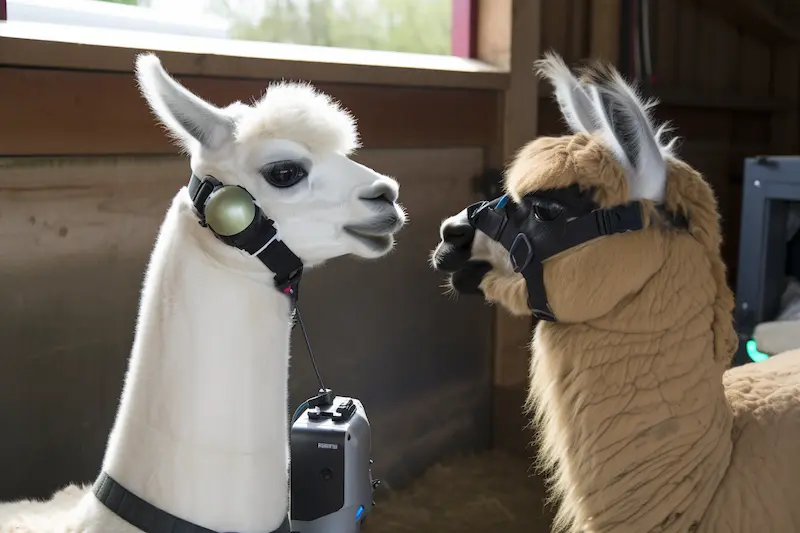Stanford HAI's Alpaca: A Game-Changing Instruction-Following Model
The Stanford Institute for Human-Centered Artificial Intelligence (HAI) has recently unveiled Alpaca, an innovative instruction-following model built on Meta AI LLaMA 7B. Utilizing OpenAI's text-da-Vinci-003, the researchers developed 52K demonstrations in a self-instruct style, which they used to train Alpaca. This model not only exhibits similar behaviors to OpenAI's text-DaVinci-003 on the self-instruct evaluation set, but it is also remarkably compact and cost-effective to reproduce.
Bridging the Budget Gap
The primary challenges of training high-quality instruction-following models on an academic budget include obtaining a strong pre-trained language model and high-quality instruction-following data. Alpaca 7B overcomes these obstacles by leveraging Meta's LLaMA models and using the self-instruct method with text-davinci-003 to generate instruction data.
Alpaca 7B's training pipeline simplifies the generation process and significantly reduces cost by using Hugging Face's training framework and techniques like Fully Sharded Data Parallel and mixed precision training. With these optimizations, training the Alpaca 7B model takes only three hours on 8 80GB A100s, costing less than $100 on most cloud compute providers.
A More Efficient Approach to Generating Instruction-Output Pairs
The researchers sought to improve upon the self-instruct method by creating examples of following instructions. They began by using the self-instruct seed set, which contains 175 instruction-output pairs crafted by humans. This seed set was fed into text-DaVinci-003, generating additional instructions based on the examples. By streamlining the generating pipeline, the team made the process more efficient and significantly reduced the cost. Utilizing the OpenAI API, they developed 52K unique instructions and related outputs for under $500.
Hugging Face Training Architecture and Methods
To refine the LLaMA models, the researchers employed Hugging Face's training architecture and methods, including Fully Sharded Data-Parallel and mixed precision training. They used the dataset of people following instructions to fine-tune a 7B LLaMA model. For their initial run, they deployed 8 80GB A100s, which cost less than $100 on most cloud computing providers. The team acknowledges the potential for further improvement in training efficiency and cost savings.
Human Evaluation: Assessing Alpaca's Performance
To gauge Alpaca's performance, the researchers employed a human evaluation method using inputs from the self-instruct evaluation set. This set, compiled by the creators of the self-instruct guides, covers a wide range of topics, such as email composition, social media, and productivity software. In a blind pairwise comparison, text-da-vinci-003 and Alpaca 7B exhibited similar performance levels.
Consistency with Text-DaVinci-003
Alpaca 7B is an instruction-following language model that closely mirrors the capabilities of OpenAI's text-davinci-003 while maintaining a smaller size and lower cost.
The performance of Alpaca 7B is qualitatively similar to text-davinci-003
Beyond the static evaluation set, the researchers conducted interactive Alpaca model tests, finding that it often displayed behavior consistent with text-davinci-003 across various inputs.
Alpaca's Limitations: Delusion, Toxicity, and Stereotyping
Alpaca, like other language models, has its shortcomings, including tendencies towards delusion, toxicity, and stereotyping. Compared to text-da-vinci-003, hallucination is a particularly common failure mode for Alpaca.
Future Work: Unraveling Training Recipes and Mitigating Threats
The research team plans to explore how the training recipe produces the model's capabilities in their future work. Additionally, they aim to better understand and mitigate the risks posed by Alpaca through techniques like automatic red teaming, auditing, and adaptive testing. By further refining this cost-effective and compact AI model, the team hopes to challenge the status quo and contribute original insights to the field of artificial intelligence.
Release and Responsible Deployment
The Alpaca 7B team is releasing several assets, including the interactive demo, data, data generation process, and training code. The model weights will also be released in the near future, subject to guidance from Meta.
The release of Alpaca 7B aims to benefit the academic community by enabling controlled scientific studies and fostering the development of new techniques to address existing model deficiencies. However, there are risks associated with any release, such as enabling bad actors to create harmful models or lowering the barrier for spam, fraud, or disinformation.
To mitigate these risks, the Alpaca 7B team has implemented a content filter using OpenAI's content moderation API and watermarked all model outputs. The demo is also restricted to non-commercial uses and must adhere to LLaMA's license agreement.
Future Directions and Opportunities
The release of Alpaca 7B presents numerous exciting opportunities for researchers to explore:
- Evaluation: Rigorous evaluation of Alpaca 7B is crucial. Researchers can use the HELM framework to assess the model's performance and identify areas of improvement.
- Safety: Further study of Alpaca 7B's risks and potential improvements in safety is needed. Methods such as automatic red teaming, auditing, and adaptive testing can help achieve this goal.
- Understanding: Gaining a deeper understanding of how capabilities arise from the training recipe can shed light on the necessary properties of base models, scaling effects, instruction data requirements, and alternatives to the self-instruct method with text-davinci-003.
Conclusion
Alpaca 7B builds on the work of numerous researchers and organizations, including Meta AI Research, the self-instruct team, Hugging Face, and OpenAI. The project is supported by the Center for Research on Foundation Models (CRFM), Stanford Institute for Human-Centered AI (HAI), and the Stanford Natural Language Processing (NLP) group.
There are several other open efforts for instruction-following LLMs and chat models worth exploring, including OpenChatKit, Open Assistant, and Carper AI.
Alpaca 7B ushers in a new era of accessible AI for academic researchers and budget constrained users, breaking down barriers and promoting innovation in the field of instruction-following language models. By empowering researchers to study the model's strengths and limitations, Alpaca 7B lays the groundwork for the development of safer, more accurate, and more ethical AI models. The release of Alpaca 7B demonstrates the power of collaborative, open-source research in driving AI advancements and fostering a more equitable AI research ecosystem.
Resources









